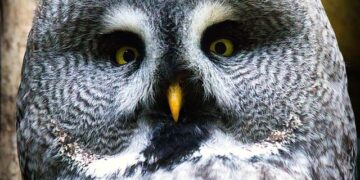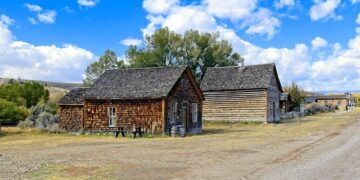In the rugged mountain ranges of Europe and Asia, a rather unusual archaeologist is quietly at work-the bearded vulture. Recent studies featured in ESA Journals reveal how this striking bird of prey acts as a natural accumulator of historical remains, offering scientists a unique window into past ecosystems and human interactions. By collecting bones and other debris in its nests and feeding sites, the bearded vulture creates invaluable repositories of ecological and cultural information. This newfound understanding not only sheds light on the species’ fascinating behavior but also opens exciting avenues for future research at the crossroads of ecology and biocultural heritage.
Bearded Vultures as Natural Archivists Unlock Clues to Past Ecosystems
Far beyond their striking appearance and ecological role as scavengers, bearded vultures serve as vital repositories of historical biodiversity. By collecting and accumulating bone remains over centuries in their nesting and roosting sites, these raptors inadvertently create natural archives that enable researchers to reconstruct past ecosystems with remarkable accuracy. The accumulated bones are often well-preserved due to the vultures’ unique feeding habits, providing priceless data on species diversity, population shifts, and even climatic variations that shaped prehistoric landscapes.
Modern ecological studies now leverage these bone assemblages to gain insights into biocultural interactions, revealing how ancient human communities may have influenced-and been influenced by-local fauna over time. Tools such as radiocarbon dating and isotopic analysis applied to these remains open new pathways in understanding regional biodiversity trends. The following table highlights key advantages of studying bearded vulture bone collections in comparison to other natural archives:
| Feature | Bearded Vulture Archives | Other Natural Archives |
|---|---|---|
| Preservation Quality | High (dry, sheltered sites) | Variable (soil or water conditions) |
| Time Span | Centuries to millennia | Often shorter or more fragmented |
| Ecological Coverage | Includes a range of vertebrates | Often limited to plants or sediments |
| Anthropogenic Signal | Indirect, through associated fauna | More direct but site-specific |
- Natural chronologies: Vulture nests as time-locked bone deposits
- Cross-disciplinary potential: Bridging ecology with archaeology and conservation biology
- Long-term monitoring: Tracking changes in predator-prey dynamics over centuries
New Research Reveals How Their Accumulated Remains Inform Biodiversity and Cultural Heritage
Recent studies have unveiled the unique role of the Bearded Vulture (Gypaetus barbatus) as a natural archivist, accumulating ossified remains over centuries in remote mountainous regions. These nested bone assemblages function as invaluable time capsules, providing a dual perspective that bridges ecological patterns with human cultural evolution. Through meticulous analysis of these accumulated remains, researchers have been able to reconstruct shifts in biodiversity, track species population dynamics, and detect environmental changes that otherwise would have gone unnoticed. The layering of bones, often from multiple species, offers a historical record akin to an ecological ledger that illuminates both extinction events and species resilience across time.
Beyond ecological insights, the role of the Bearded Vulture intersects with anthropological narratives, shedding light on ancient human-animal interactions. The accumulation sites often coincide with historical trade routes and settlement areas, suggesting that the vulture’s bone deposits may serve as markers for past human activities and cultural practices. Key findings indicate:
- Species diversity indicators that reveal local extinctions and introductions.
- The correlation between bone assemblages and historic climatological events.
- Evidence of ancient hunting patterns discerned through bone wear and breakage.
- Insight into past landscape use by human communities.
| Remains Type | Ecological Insight | Cultural Reference | |
|---|---|---|---|
| Ungulate Bones | Population fluctuations | Hunting and pastoralism | |
| Bird Bones | Species diversity and migration | Symbolism and ritual use | |
| Small Mammal Bones | Ecosystem health indicators | Food resource management | |
| Reptile Bones | Climate and habitat shifts | Mythological associations |
| Study Aspect | Potential Benefit | ||
|---|---|---|---|
| Bone Accumulation Mapping | Reconstruction of historical fauna diversity | ||
| Ethnobiological Surveys | Understanding cultural connections to vultures | ||
| Climate Impact Analysis | Tracing environmental changes via remains | ||
| Conservation Education |
| Study Aspect |
Potential Benefit |
|
| Bone Accumulation Mapping | Reconstruction of historical fauna diversity | ||
| Ethnobiological Surveys | Understanding cultural connections to vultures | ||
| Climate Impact Analysis | Tracing environmental changes via remains | ||
| Conservation Education | Raising public awareness and support for vulture protection |
Let me know if you would like assistance with anything else, such as styling improvements or content expansions!
Wrapping Up
As researchers continue to uncover the unique role of the bearded vulture as a natural collector of historical remains, new pathways are opening for both ecological and biocultural investigations. This fascinating bird, long admired for its impressive wingspan and scavenging habits, is proving to be a valuable archivist of the past, preserving fragments that offer rare glimpses into ancient ecosystems and human history. Future studies inspired by these findings promise to deepen our understanding of biodiversity, conservation, and cultural heritage, highlighting the intricate connections between wildlife and the stories embedded in their environment. The bearded vulture’s legacy, it seems, extends far beyond the skies-anchoring it firmly as a key subject for ongoing scientific exploration.
















![[News] Japan Develops 10nm Nanoimprint Technology, with Potential to Tackle EUV Bottleneck – TrendForce](https://earth-news.info/wp-content/uploads/2025/12/329851-news-japan-develops-10nm-nanoimprint-technology-with-potential-to-tackle-euv-bottleneck-trendforce-360x180.jpg)














